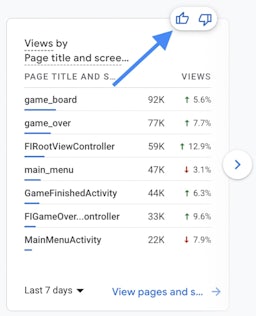Welcome to the latest blog from Impression on Paid Search Industry Updates, where we uncover the latest PPC trends to help you stay ahead of the curve.
As we leave the busy Christmas season behind and enter the new year, updates within the PPC industry have remained relatively slow, as many people in the industry are returning from a well-deserved break.
However, updates are still updates, so join us as we cover the most prominent pieces of news over the last few weeks!
Keep reading to discover:
- Google introduces new GA4 features to facilitate migration from Universal Analytics
- Google launches new features on Google Ads’ insights page
- Microsoft offers automatic upgrade to Responsive Search Ads as they sunset Expanded Text Ads in February
- Microsoft Ads introduces Video Ads to the Microsoft Audience Network
As usual, traffic light imagery is featured throughout to indicate the importance of each new update – red denoting a priority update, green representing a less important update and amber lying somewhere in the middle.
Google introduces new GA4 features to facilitate migration from Universal Analytics

A new year has arrived, and with it comes the realisation that we are ever so closer to reaching the twilight of Universal Analytics’ lifespan, with the platform ceasing its collection of new data on July 1st, 2023. In turn, the platform will be replaced with Google Analytics 4 (GA4), with many advertisers having already prepared for the migration over recent months. However, for those that are still yet to migrate, or are in the process of doing so, Google has introduced some new features to help with this process.
The first of these new features is the ability to recreate Universal Analytics audiences in GA4. This can be done using the GA4 Migrator for Google Analytics Google Sheets add-on, allowing audiences based on dimensions and metrics that are the same between both platforms to be recreated. For audiences where dimensions/metrics differ, audience definitions can be altered in the spreadsheet to their GA4 counterparts. Furthermore, the spreadsheet will identify whether audiences can or cannot be recreated, and provide information as to why they may not be able to.

The other notable change that Google has implemented is the ability to personalise the GA4 home page, something which will be unique to each user’s dashboard. One of the ways this can be done is by altering the metrics and dimensions of the real-time cards, allowing for quicker analysis. Furthermore, users will be provided with suggestions when using a new property to bring important information to light, along with having the ability to provide feedback by giving a ‘thumbs up’ or ‘thumbs down’ over the top right of a card, allowing the platform to provide more helpful information in the future.

What does this mean for me?
First and foremost, the introduction of these features should be a good reminder for advertisers to implement GA4 as soon as possible, before support for Universal Analytics ceases later this year. The earlier this transition is completed, the longer the period of adaptation you will have to ensure migration is as smooth as possible.
For those still migrating, these features should help to facilitate this transition, as the customisation and tools given should allow for more familiarity if the dashboard is changed to be as close to the Universal Analytics one as possible. Learn more about how you can prepare for Google Analytics 4.
Google launches new features on Google Ads’ insights page

Google Ads’ insights page has been a very useful tool for advertisers since its introduction two years ago, with Google aiming to provide us with key information regarding changing consumer behaviour. With so much turbulence surrounding society over recent years, with Google quoting recent inflation and changes in consumer preferences as examples, four new features have been introduced to the insights page to further inform overall marketing strategies.
The first of these new features is search term insights, which allocate search terms into broader, intent-based categories, making it easier for advertisers to spot what themes are most popular amongst consumers without examining each individual search term. These insights will be further enhanced by displaying metrics such as conversion performance, search volume and search volume growth.

Asset insights are another new feature, giving advertisers a better understanding as to which creative assets resonate best with customers, along with helping to identify highly-engaged audiences and inform assets and landing pages created for each audience.
Next are audience insights, which help by providing information relating to the characteristics of the people that engage with a business. Some examples of how this will help are by giving us a better idea of what customers really care about by providing key insights on a business’ top audience, along with combining with the previously mentioned asset insights to identify which audience segments react best to which assets.
The final of these new features is change history insights, which analyse changes made across Google Ads accounts and identify how these have impacted performance. These will be more prevalent when significant shifts happen to key campaign metrics and will identify which account changes may have caused this and advise the best course of action.

What does this mean for me?
As Google has stated in their article, these changes come as part of their ongoing goal to provide advertisers with a more streamlined and simpler way to understand their customers, especially during busier and more turbulent periods such as the holiday season just gone.
However, these changes will likely be an effective new tool for advertisers to use year-round, not just during peak periods for their accounts. Whether simply helping to cut down time used looking for search term reports, or providing key insights that help to modify an overall campaign’s strategy, we’re sure that many advertisers will welcome these changes with open arms.
Microsoft offers automatic upgrade to Responsive Search Ads as they sunset Expanded Text Ads in February

Microsoft Advertising announced early last year it will transition from Expanded Text Ads to Responsive Search Ads in an effort to remain competitive and adapt to the new digital landscape. With the migration deadline of 1st February 2023 fast approaching, Microsoft offers advertisers support with a one-time automatic upgrade.
Starting from the 3rd of January 2023, advertisers can apply this upgrade to their accounts with the click of a button. Microsoft will use the Expanded Text Ads which have the best performance in the account when creating the new Responsive Search Ads and will only create Responsive Search Ads where the ad group does not have one, ensuring therefore that each ad group in the account has an active Responsive Search Ad.
Of course, advertisers who prefer to do the upgrade manually have this option, by clicking “No, thanks” on the pop-up window from the account dashboard. If advertisers decide to manually upgrade their ads, they should consider using the Google Import tool and simply import their best-performing Responsive Search Ads from their Google Account into Microsoft, to ensure consistency and alignment across the ad copy in their accounts.
What does this mean for me?
Switching from Expanded Text Ads to Responsive Search Ads has several performance benefits for accounts, with Microsoft reporting that advertisers who did the upgrade saw a 7% improvement in conversion rate across their campaigns.
Hence, advertisers should start auditing their Microsoft accounts which are still using Expanded Text Ads and take advantage of this automatic upgrade from Microsoft to ensure their accounts are future-proofed for the fast-approaching February migration, but also for the ever-changing and competitive marketing landscape.
Microsoft Ads introduces Video Ads to the Microsoft Audience Network

Microsoft announced late December the launch of video ads in the Microsoft Audience Network; this is an immersive and visually engaging ad format which complements existing search and image ads, is designed for sound-off and can last between 6 and 120 seconds.
Video ads allow marketers to communicate their message to a wider and more relevant audience, unavailable on other search engines. For instance, 39% of users watch videos on Microsoft Search Network rather than on YouTube, while 57% of users prefer videos on Microsoft Search Network compared to Facebook, suggesting that marketers using Microsoft video ads can reach a large and untapped market.
Moreover, Microsoft offers a wide range of targeting options in video ads, from Remarketing, LinkedIn Profile Targeting, Similar Audiences to Customer Match or Custom Audiences. Hence, marketers can leverage historical data about their customers, as well as user browser behaviour and web activity to reach both current and new customers. Besides targeting, Microsoft provides flexibility in terms of bidding strategies to better suit the business needs of the company. If a business wants to focus on reach, it can use a CPM strategy, which will count an impression when a user watches 2 seconds of the video or clicks on the video. Instead, if video views are KPIs for the business, the campaign can use a CPV strategy, which counts 1 video view when a user watches 15 seconds of the ad or clicks on it. Ultimately, businesses measuring traffic to their website can use a CPC bidding strategy which will count only when the user clicks on the video ad.

What does this mean for me?
Considering the long customer journey and the increased difficulty nowadays to connect to the right audience, the introduction of video ads allows marketers in the UK and several other countries to reach a larger customer base and catch their attention through videos. Marketers using video ads can utilise this new ad format in their top-of-funnel strategy, such as raising brand awareness or promoting new offerings. As videos are a highly visual and immersive type of advertising, users can easily create brand associations, connect with the brand and remember CTAs seen in the videos.
Moreover, utilising video ads alongside search ads has proven to drive a 50% higher conversion rate compared to when accounts were only using search campaigns. This showcases a substantial improvement in performance and suggests the high growth potential of an account which integrates video ads in its strategy.
Look out for our next blog in February for more paid search industry updates to inspire your PPC strategy. If you want to talk about your business’ aspirations, get in touch!





